What Is a Canvas Painting Kit?
A canvas painting kit is a set of tools for creating artwork on canvas. It offers all the basic materials needed to start painting, making it ideal for beginners. Whether you’re exploring art for fun or to learn, these kits simplify the process.
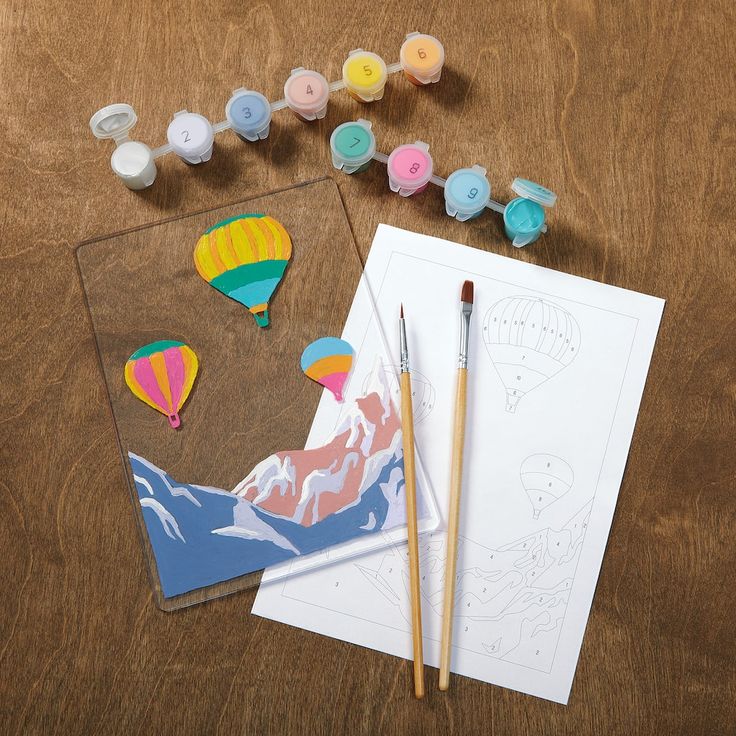
Components Included in a Canvas Painting Kit
Most canvas painting kits include essential supplies to help you start painting. Typical components are:
- Canvas: Pre-stretched canvas sheets or canvas boards for painting.
- Paint: Acrylic or watercolor paints in various colors.
- Brushes: A selection of brushes for different strokes and techniques.
- Palette: For mixing paints easily.
- Accessories: Items like an easel, sharpener, apron, or paint knives.
These items vary based on the kit, but most have everything you need to complete your first painting project.
Benefits of Using a Kit for Beginners
Canvas painting kits are extremely beginner-friendly and offer the following benefits:
- Convenience: All necessary tools are provided in one package.
- Affordability: Kits are often cheaper than buying each item separately.
- Organization: Supplies are neatly packaged, easy to store and transport.
- Learning Support: Many kits include guides or instructional sheets.
- Motivation: Having everything ready encourages you to start painting immediately.
Using a canvas painting kit is a great way to foster creativity and enjoy a new hobby.
How to Choose the Right Canvas Painting Kit
Selecting the right canvas painting kit is important for a successful painting experience. With so many options available, you need to consider factors that match your needs and skill level. Make thoughtful choices to ensure you have an enjoyable and smooth start.
Factors to Consider When Selecting a Kit
Here are key factors to keep in mind when choosing a canvas painting kit:
- Kit Components: Look for essentials like canvas, paints, brushes, and accessories.
- Quality of Supplies: Ensure materials in the kit are durable and good-quality.
- Paint Type: Decide whether you prefer acrylic, watercolor, or oil paints.
- Skill Level: Choose a beginner-friendly kit if you are new to painting.
- Price: Compare kits based on affordability and value for money.
- Additional Features: Kits with guides or tutorials are ideal for beginners.
Checking these details will help you find a kit that meets your needs and budget.
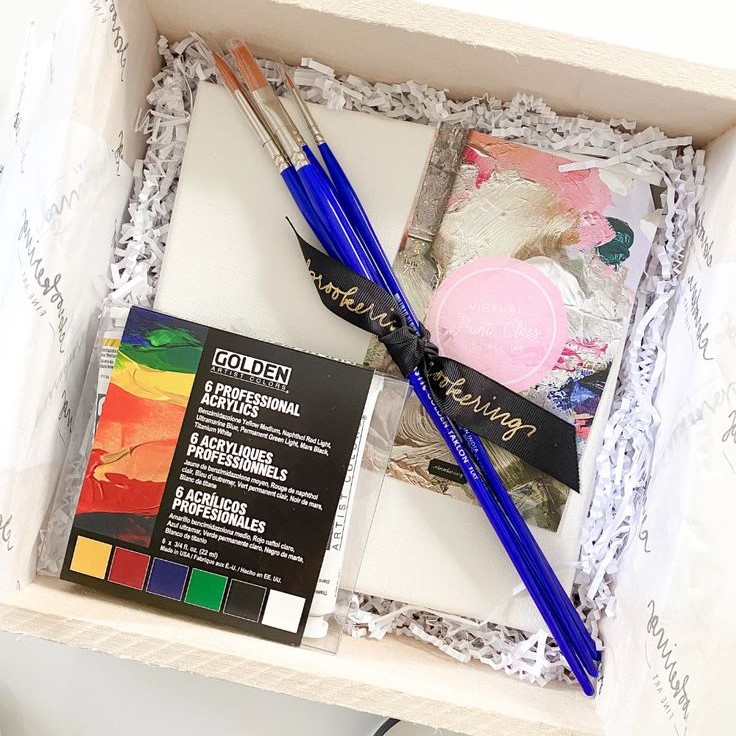
Recommended Brands and Products for Beginners
For beginners, several brands offer excellent canvas painting kits with simple materials:
- Royal & Langnickel: Known for quality brushes and paints.
- Artlicious: Affordable kits with diverse paint options.
- Arteza: Offers versatile kits with extras like painting guides.
- Zenacolor: Great for vibrant color sets and sturdy accessories.
- Golden Artist Colors: A higher-end option for professional-grade supplies.
These brands provide reliable kits designed to support your painting journey conveniently.
Essential Tools and Supplies for Canvas Painting
Understanding the tools and supplies you need is crucial for canvas painting success. Each tool plays a unique role.
Brushes: Types and Uses
Brushes are vital for achieving specific strokes and textures. Common types of brushes:
- Flat Brushes: Ideal for bold strokes and filling large areas.
- Round Brushes: Perfect for fine details and thin lines.
- Fan Brushes: Great for blending and creating soft textures.
- Angle Brushes: Useful for edges and detailed work.
- Detail Brushes: Designed for tiny, intricate designs.
Each brush type serves a distinct purpose. Select brushes based on your painting needs.
Paint Selection: Acrylic vs. Oil vs. Watercolor
Choosing the right paint enhances your art experience. Here’s a breakdown of paint types:
- Acrylic Paint: Fast-drying, versatile, and beginner-friendly.
- Oil Paint: Slower drying, ideal for blending and layering.
- Watercolor Paint: Lightweight and great for soft, transparent styles.
Consider your skill level and preferred technique when selecting paint.
Additional Accessories to Enhance Your Painting
Supplementing your canvas painting kit with accessories can improve results. Essential items include:
- Palette Knives: For mixing paint and creating unique textures.
- Easels: Help maintain posture and provide stability.
- Aprons: Protect clothing from paint spills.
- Palette: Essential for mixing colors efficiently.
- Storage Containers: Keep brushes, paints, and accessories organized.
Adding these tools enhances creativity and simplifies painting sessions.
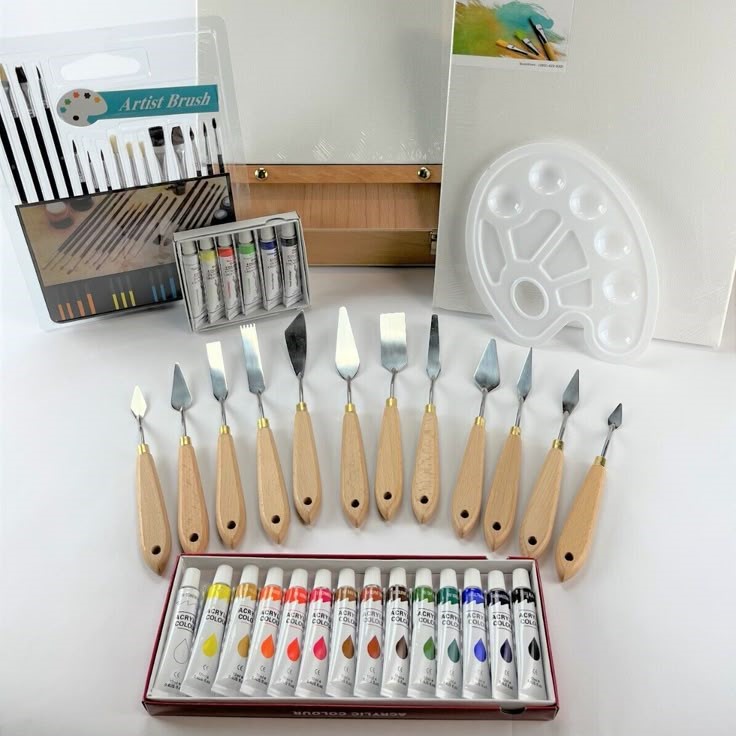
Setting Up Your Workspace
Creating a proper workspace is essential for an enjoyable painting experience. A well-organized and safe area boosts creativity and ensures smooth painting sessions. Here’s how you can prepare the perfect spot for your canvas painting adventures.
Tips for Organizing Your Painting Area
- Choose a Dedicated Spot: Find a space that is quiet and has good lighting.
- Select a Stable Surface: Use a sturdy table or an easel for consistent support while painting.
- Arrange Your Supplies: Keep brushes, paints, and accessories within easy reach.
- Use Storage Solutions: Organize small items in containers to prevent clutter.
- Protect Your Surface: Place a drop cloth or old newspaper to avoid paint stains.
- Ventilation Matters: Ensure proper airflow, especially if using strong-smelling paints like oils.
- Add Personalized Touches: Include inspirational items like photos or artwork to spark your creativity.
Safety Precautions for Painting
- Avoid Skin Contact: Wear gloves when handling paints or other chemicals.
- Use Non-Toxic Materials: Prefer kits with eco-friendly and safe paints, especially for beginners.
- Maintain Cleanliness: Clean brushes and tools after every use to avoid hard buildups.
- Handle Sharps Carefully: Keep palette knives and other sharp tools stored safely.
- Keep Children Away: Store paints and accessories out of reach of kids.
- Stay Alert with Open Flames: Avoid open flames near oil-based paints or solvents.
Preparing your workspace thoughtfully enhances both safety and comfort, allowing you to focus on your art.
Step-by-Step Guide to Using
Using a canvas painting kit can be both fun and rewarding. Following a step-by-step process ensures smooth execution and beautiful results. Here’s how to get started.
Preparing Your Canvas
- Inspect Your Canvas: Check for tears or uneven surfaces before you begin.
- Prime Your Canvas: Use gesso to prep the canvas for better texture and paint adherence.
- Secure Your Canvas: Place it on a stable easel or flat surface to prevent movement.
- Choose Your Layout: Sketch an outline if you prefer guided painting.
- Arrange Supplies: Keep all brushes, paints, and water accessible for quick use.
- Protect Your Workspace: Lay down a cloth or newspaper to catch spills.
Proper preparation sets the foundation for a successful painting project.
Techniques to Apply Paint Effectively
- Know Your Brushes: Use appropriate brushes for detailed, broad, or textured strokes.
- Work in Layers: Start with thin layers for a smooth finish and add more for depth.
- Mix Colors Thoroughly: Use a palette to blend colors until you achieve the desired shade.
- Apply Paint Gradually: Avoid heavy coats; instead, build up coverage over time.
- Use Controlled Strokes: Be intentional with your brushstrokes to create clean lines and textures.
- Experiment with Effects: Try dry brushing or splattering for creative finishes.
Using proper techniques ensures your painting comes alive with vibrant colors and precision.
Layering and Blending for Depth and Texture
- Start with Base Layers: Apply lighter colors as the foundation for your painting.
- Add Gradually: Introduce darker shades for shadows or highlights step by step.
- Blend Smoothly: Use soft brushes or sponges to blur edges for a seamless transition.
- Create Textures: Experiment with palette knives or brushes for textured surfaces.
- Focus on Details: Refine intricate areas once the main layers are complete.
- Evaluate Progress: Step back frequently to assess balance and adjust depth.
Layering and blending elevate your art, giving it dimension and professional appeal.
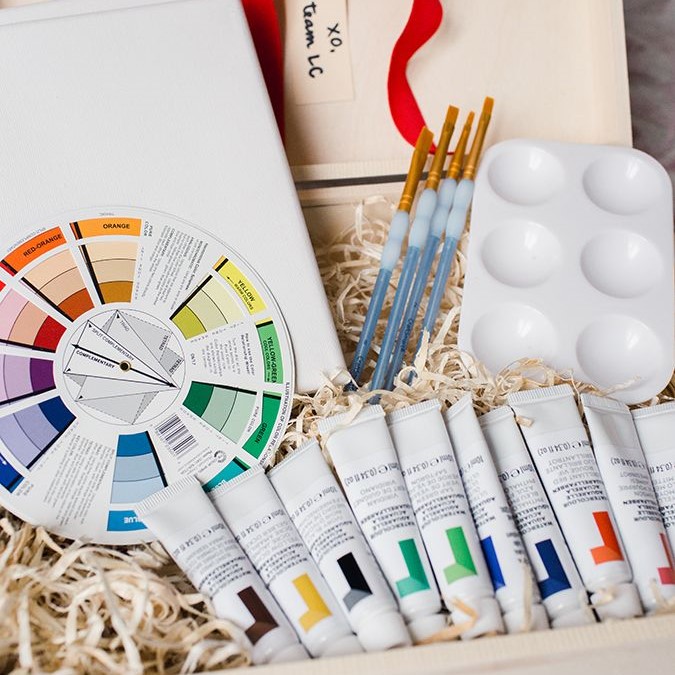
Common Mistakes and How to Avoid Them
Every beginner makes mistakes when learning to paint. Identifying these errors helps improve your skills. Here are common pitfalls and tips to avoid them.
Overloading Paint on Brushes
Using too much paint on your brush can ruin your artwork. Here’s how to avoid this mistake:
- Dip Lightly: Only dip the tip of the brush into the paint. Avoid submerging it entirely.
- Remove Excess Paint: Gently wipe the brush on the edge of the palette to remove excess paint.
- Work in Layers: Start with thin layers of paint. Gradually add more for better control.
- Use Proper Brush Sizes: Choose the right brush for the area. Smaller brushes are perfect for details.
- Clean Often: Wash brushes regularly while painting to prevent buildup and ensure smooth strokes.
Overloading paint leads to uneven textures and wasted materials. Embrace minimal strokes for clean results.
Misusing Color Combinations
Mixing colors incorrectly can lead to dull or muddy results. Here’s how to manage colors:
- Learn Basic Color Theory: Understand primary, secondary, and complementary colors before blending.
- Test Before Applying: Mix colors on the palette first. Test on scrap paper to see the result.
- Avoid Overmixing: Stop blending once you achieve the desired shade. Overmixing reduces vibrancy.
- Use Quality Paints: Poor-quality paints often mix poorly. Choose reliable supplies from your canvas painting kit.
- Plan Your Palette: Select a color scheme before beginning. Limit the number of colors to stay consistent.
By mastering color combinations, your artwork will look lively and well-balanced.
Avoiding these common mistakes will help you create beautiful, polished paintings using your canvas painting kit.
Tips for Improving Your Canvas Painting Skills
Enhancing your canvas painting skills requires time, effort, and consistency. By embracing new exercises and techniques, you can gradually improve your abilities and explore your creativity. Let’s dive into helpful strategies to grow as a painter.
Practice Exercises for Beginners
Practice makes perfect when it comes to painting. Here are some beginner-friendly exercises to build your skills:
- Stroke Practice: Use different brushes to create various strokes on a blank canvas.
- Color Blending: Combine primary colors to explore how secondary and tertiary colors are formed.
- Basic Shapes: Paint simple objects like circles, rectangles, or flowers to improve control.
- Gradient Transitions: Practice creating smooth gradients from light to dark colors.
- Texture Experimentation: Use sponges, palette knives, or combs to develop unique textures.
- Monochromatic Studies: Paint a scene using one color and its shades to learn values.
These exercises are valuable for building confidence and experimenting with different techniques.
Exploring Different Styles and Techniques
Trying new styles and techniques helps you discover your artistic preferences. Here are some ideas:
Abstract Art
- Emphasis on Elements: In abstract art, the focus shifts away from realistic representation to the exploration of colors, shapes, and patterns. Artists prioritize emotional expression and the visual impact of these elements over detailed depictions.
- Creative Freedom: This style allows artists to experiment with forms and hues, inviting viewers to interpret the artwork in diverse ways. The lack of recognizable subject matter encourages imaginative engagement and personal reflection.
Impressionism
- Technique of Brushwork: Impressionist artists use short, visible brush strokes that capture the essence of a scene rather than intricate details. This technique creates a sense of spontaneity and movement within the artwork.
- Depicting Light and Atmosphere: The goal of impressionism is to convey an impression of light and motion, often by painting outdoors (en plein air) to capture the changing qualities of natural light at different times of day.
Realism
- Accurate Representation: Realism is characterized by the commitment to depicting subjects—whether they be objects, people, or landscapes—as accurately and truthfully as possible. This involves careful observation and meticulous attention to detail.
- Reflecting Everyday Life: Realist artists focus on portraying ordinary scenes and experiences, emphasizing authenticity and the human condition. This style often aims to depict life without idealization or embellishment, connecting personally with viewers.
Mixed Media
- Combining Materials: In mixed media art, artists blend different materials and techniques—such as paints, inks, pencils, and even fabrics—to create unique and layered effects. This approach encourages innovation and experimentation in art-making.
- Diverse Textures and Effects: By incorporating various materials, mixed media creates a rich tapestry of textures and visual contrasts. It allows for more complex storytelling and emotional expression within the artwork.
Layering Techniques
- Exploring Glazing and Underpainting: Artists can use layering techniques like glazing (applying thin, transparent layers of paint) and underpainting (creating an initial base of color) to add depth, richness, and luminosity to their artwork.
- Building Complexity: These techniques enable artists to achieve a sense of three-dimensionality and enhance the visual interest of their work, as well as to create a harmonious blend of colors.
Negative Space
- Importance of Empty Areas: Emphasizing negative space involves highlighting the empty areas surrounding the main subject of a composition. This technique can create a striking contrast that draws attention to the subject itself.
- Enhancing Composition: By effectively using negative space, artists can achieve balance and harmony in their work, making the overall composition more dynamic and visually compelling. It invites viewers to engage with the artwork on a deeper level.
Improving your canvas painting skills takes practice, experimentation, and an open mind. Enjoy the learning process!
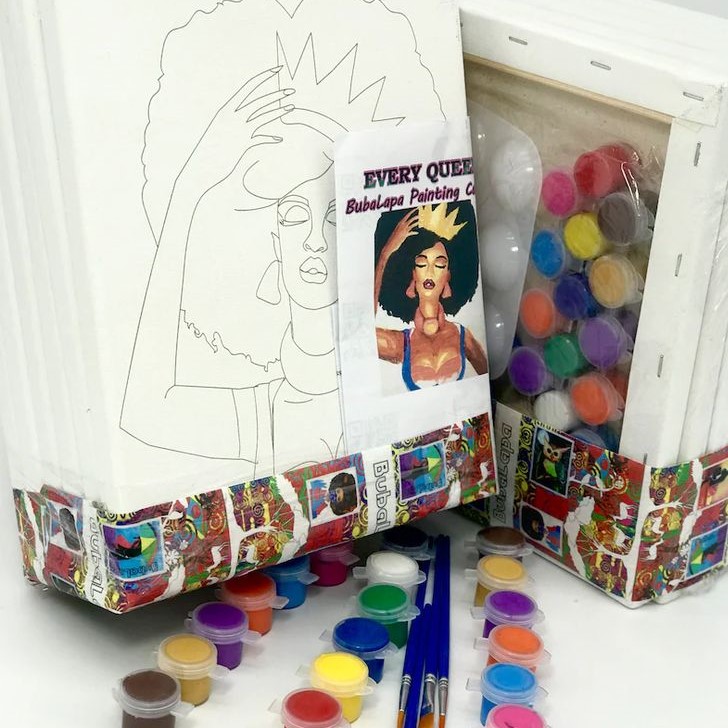
Conclusion: Embrace Your Journey
In conclusion, the canvas painting kit provides you with vital knowledge to embark on your artistic journey. With the right tools, techniques, and mindset, you’re equipped to create beautiful pieces of art.
As you familiarize yourself with your canvas painting kit, remember that the purpose of painting is to express yourself. Allow your creativity to flow, take every opportunity to learn, and don’t forget to have fun in the process. No matter the outcome, every stroke is a step closer to becoming the artist you aspire to be! Embrace this journey, and let your inner artist shine through!